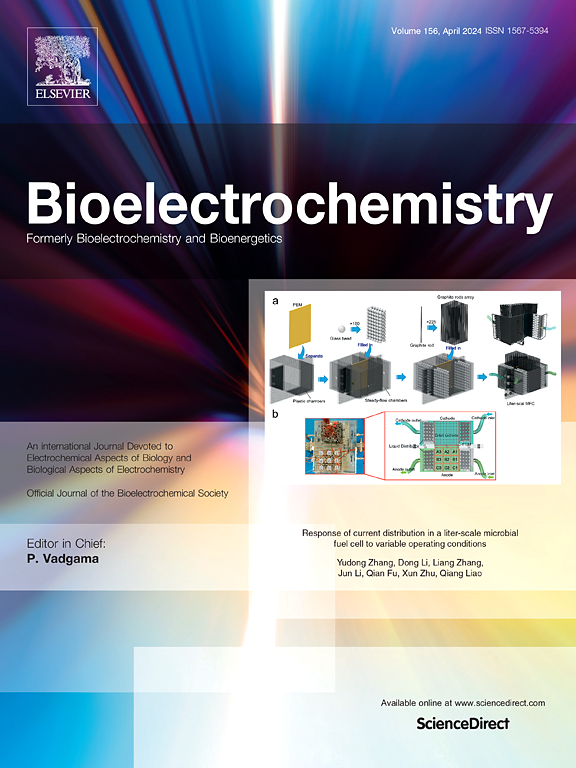Three detection modes with one electrode: A multifunctional electrochemical sensing platform for thrombin, p53 gene, and cholesterol detection
IF 4.5
2区 化学
Q1 BIOCHEMISTRY & MOLECULAR BIOLOGY
引用次数: 0
Abstract
The development of diverse biomarker detection platforms is crucial to efficient and low-cost assays. Unlike most conventional multi-target methods requiring complex probe labeling and prone to signal cross-talk, a novel multifunctional sensor incorporating host-guest chemistry in electrochemical assays was developed to detect protein, nucleic acid, and small molecule with a single electrode in this work. This sensor operates in three distinct modes: protein detection, nucleic acid detection, and small molecule detection. In the protein detection mode, the methylene blue (MB)-labeled probe recognized the thrombin and formed a probe/thrombin complex, inducing fewer probes to be captured by the β-cyclodextrin (β-CD) and enabling a measurable electrochemical signal change. In the nucleic acid detection mode, the p53 gene interacted with the corresponding probe and formed a rigid double-stranded DNA (dsDNA) structure, reducing the electron transfer rate constant (ks) and inhibiting MB signal transmission. In the small molecule detection mode, cholesterol competitively bonded with the host molecules and removed MB from the β-CD cavity, leading to an electrochemical signal decrease. Under optimized detection conditions, this sensor displayed an effective analytical performance for thrombin, p53 gene, and cholesterol, achieving low detection limits of 61.7 pM, 7.3 nM, and 14.3 μM, respectively. Importantly, this platform enables rapid regeneration in the nucleic acid detection mode and reliable operation in complex samples, outperforming previous multi-target detecting methods in reusability, anti-interference capacity, and ease of construction. By eliminating multi-labeling steps and minimizing cross-talk on a single electrode, our design may inspire more innovative multifunctional sensors for multiplexed biomarker diagnostics.
三种检测模式与一个电极:一个多功能电化学传感平台凝血酶,p53基因,和胆固醇检测
开发多种生物标志物检测平台对于高效、低成本的检测至关重要。与大多数需要复杂探针标记和易产生信号串扰的传统多靶点方法不同,本研究开发了一种新型多功能传感器,该传感器结合了电化学分析中的主客体化学,可以用单个电极检测蛋白质,核酸和小分子。这种传感器在三种不同的模式下工作:蛋白质检测,核酸检测和小分子检测。在蛋白质检测模式下,亚甲基蓝(MB)标记的探针识别凝血酶并形成探针/凝血酶复合物,诱导较少的探针被β-环糊精(β-CD)捕获,从而实现可测量的电化学信号变化。在核酸检测模式下,p53基因与相应的探针相互作用,形成刚性双链DNA (dsDNA)结构,降低电子传递速率常数(ks),抑制MB信号传递。在小分子检测模式下,胆固醇与宿主分子竞争性结合,将MB从β-CD腔中去除,导致电化学信号减弱。在优化的检测条件下,该传感器对凝血酶、p53基因和胆固醇具有良好的分析性能,检测限分别为61.7 pM、7.3 nM和14.3 μM。重要的是,该平台实现了核酸检测模式的快速再生和复杂样品的可靠运行,在可重用性、抗干扰能力和易于构建方面优于以往的多靶点检测方法。通过消除多个标记步骤并最大限度地减少单个电极上的串扰,我们的设计可能会激发更多用于多路生物标志物诊断的创新多功能传感器。
本文章由计算机程序翻译,如有差异,请以英文原文为准。
求助全文
约1分钟内获得全文
求助全文
来源期刊

Bioelectrochemistry
生物-电化学
CiteScore
9.10
自引率
6.00%
发文量
238
审稿时长
38 days
期刊介绍:
An International Journal Devoted to Electrochemical Aspects of Biology and Biological Aspects of Electrochemistry
Bioelectrochemistry is an international journal devoted to electrochemical principles in biology and biological aspects of electrochemistry. It publishes experimental and theoretical papers dealing with the electrochemical aspects of:
• Electrified interfaces (electric double layers, adsorption, electron transfer, protein electrochemistry, basic principles of biosensors, biosensor interfaces and bio-nanosensor design and construction.
• Electric and magnetic field effects (field-dependent processes, field interactions with molecules, intramolecular field effects, sensory systems for electric and magnetic fields, molecular and cellular mechanisms)
• Bioenergetics and signal transduction (energy conversion, photosynthetic and visual membranes)
• Biomembranes and model membranes (thermodynamics and mechanics, membrane transport, electroporation, fusion and insertion)
• Electrochemical applications in medicine and biotechnology (drug delivery and gene transfer to cells and tissues, iontophoresis, skin electroporation, injury and repair).
• Organization and use of arrays in-vitro and in-vivo, including as part of feedback control.
• Electrochemical interrogation of biofilms as generated by microorganisms and tissue reaction associated with medical implants.
 求助内容:
求助内容: 应助结果提醒方式:
应助结果提醒方式:


